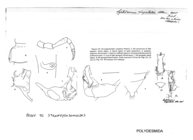MilliBase
MilliBase taxon details
Strongylosomides virgulatus (Attems, 1901)
1600264 (urn:lsid:marinespecies.org:taxname:1600264)
accepted
Species
Leptodesmus virgulatus Attems, 1901 · unaccepted
(of Leptodesmus virgulatus Attems, 1901) Attems, C. M. T. Graf von (1901). Neue Polydesmiden des Hamburger Museums. Mitteilungen aus dem Naturhistorischen Museum in Hamburg, 18: 83-107. Hamburg, available online at http://biodiversitylibrary.org/page/29384864
page(s): 91; note: figs 19-21 [details]
page(s): 91; note: figs 19-21 [details]
Type locality contained in Brazil
type locality contained in Brazil [from synonym] [view taxon] [details]
Sierwald, P.; Decker, P.; Spelda, J. (2025). MilliBase. Strongylosomides virgulatus (Attems, 1901). Accessed at: https://www.millibase.org/aphia.php?p=taxdetails&id=1600264 on 2025-09-15
Date
action
by
original description
(of Leptodesmus virgulatus Attems, 1901) Attems, C. M. T. Graf von (1901). Neue Polydesmiden des Hamburger Museums. Mitteilungen aus dem Naturhistorischen Museum in Hamburg, 18: 83-107. Hamburg, available online at http://biodiversitylibrary.org/page/29384864
page(s): 91; note: figs 19-21 [details]
additional source Weidner, H. (1960). Die Entomologischen Sammlungen des Zoologischen Staatsinstituts und Zoologischen Museums Hamburg. III. Teil. Chilopoda und Progoneata. Mitteilungen aus dem Hamburgischen zoologischen Museum und Institut, 58: 57-104. Hamburg
page(s): 84 [details]
additional source Brölemann, H. W. (1929). Myriapodes recueillis aus Brésil par M. le professeur Caullery, membre de l'institut. Mémoires de la société zoologique de France, 29(1): 1-37
page(s): 35 [details]
additional source Brölemann, H. W. (1909). Os myriapodos do Brazil. Catalogos da Fauna Brazileira, 2 : 1-94, I-XXI. São Paulo, available online at https://biodiversitylibrary.org/page/33958361
page(s): 73 [details]
additional source Golovatch, S. I.; Bouzan, R. S.; Gallo, J. S.; Bichuette, M. E. (2022). A new genus and two new species of the millipede family Chelodesmidae from Bahia state, northeastern Brazil, including a likely troglobiont (Diplopoda, Polydesmida). <em>Zootaxa.</em> 5155(1): 87-104., available online at https://doi.org/10.11646/zootaxa.5155.1.4
page(s): 91 [details]
new combination reference Hoffman, R. L. (1954). On three poorly-known neotropical milliped genera (Polydesmida, Eurydesmidae). Proceedings of the Entomological Society of Washington, 56(4): 215-221
page(s): 218; note: as Cornalatus virgulatus [details]
new combination reference Attems, C. M. T. Graf von (1931). Die Familie Leptodesmidae und andere Polydesmiden. Zoologica (Stuttgart), (79): 1-150. Stuttgart
page(s): 51; note: fig 74; as Strongylosomides virgulatus [details]
new combination reference Hoffman, R. L. (1979). Chelodesmid studies. XV. The identity and status of the generic name Strongylosomides Attems. Myriapodologica, 1 (3): 19-26. Radford
page(s): 23; note: figs 2-8; as Strongylosomides virgulatus [details]
page(s): 91; note: figs 19-21 [details]
additional source Weidner, H. (1960). Die Entomologischen Sammlungen des Zoologischen Staatsinstituts und Zoologischen Museums Hamburg. III. Teil. Chilopoda und Progoneata. Mitteilungen aus dem Hamburgischen zoologischen Museum und Institut, 58: 57-104. Hamburg
page(s): 84 [details]
additional source Brölemann, H. W. (1929). Myriapodes recueillis aus Brésil par M. le professeur Caullery, membre de l'institut. Mémoires de la société zoologique de France, 29(1): 1-37
page(s): 35 [details]
additional source Brölemann, H. W. (1909). Os myriapodos do Brazil. Catalogos da Fauna Brazileira, 2 : 1-94, I-XXI. São Paulo, available online at https://biodiversitylibrary.org/page/33958361
page(s): 73 [details]
additional source Golovatch, S. I.; Bouzan, R. S.; Gallo, J. S.; Bichuette, M. E. (2022). A new genus and two new species of the millipede family Chelodesmidae from Bahia state, northeastern Brazil, including a likely troglobiont (Diplopoda, Polydesmida). <em>Zootaxa.</em> 5155(1): 87-104., available online at https://doi.org/10.11646/zootaxa.5155.1.4
page(s): 91 [details]
new combination reference Hoffman, R. L. (1954). On three poorly-known neotropical milliped genera (Polydesmida, Eurydesmidae). Proceedings of the Entomological Society of Washington, 56(4): 215-221
page(s): 218; note: as Cornalatus virgulatus [details]
new combination reference Attems, C. M. T. Graf von (1931). Die Familie Leptodesmidae und andere Polydesmiden. Zoologica (Stuttgart), (79): 1-150. Stuttgart
page(s): 51; note: fig 74; as Strongylosomides virgulatus [details]
new combination reference Hoffman, R. L. (1979). Chelodesmid studies. XV. The identity and status of the generic name Strongylosomides Attems. Myriapodologica, 1 (3): 19-26. Radford
page(s): 23; note: figs 2-8; as Strongylosomides virgulatus [details]
 Present
Present  Inaccurate
Inaccurate  Introduced: alien
Introduced: alien  Containing type locality
Containing type locality
